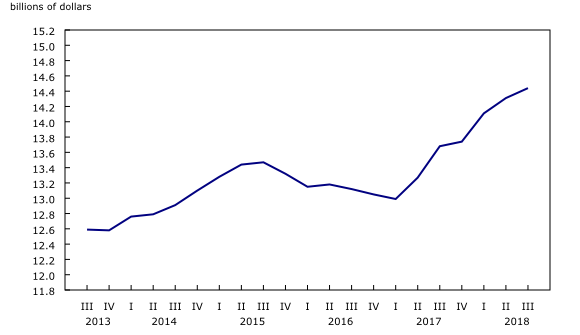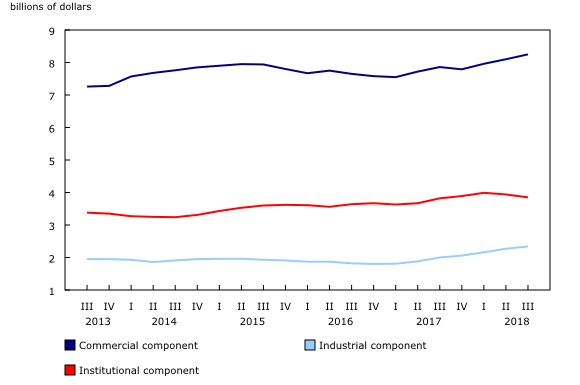Investment in non-residential building construction, third quarter 2018
Archived Content
Information identified as archived is provided for reference, research or recordkeeping purposes. It is not subject to the Government of Canada Web Standards and has not been altered or updated since it was archived. Please "contact us" to request a format other than those available.
Released: 2018-10-22
$14.4 billion
Third quarter 2018
0.9% 
(quarterly change)
Investment in non-residential building construction rose 0.9% from the second quarter to $14.4 billion in the third quarter. The commercial (+$141.6 million) and industrial (+$75.8 million) components increased, while the institutional component declined by $86.9 million.
Quarterly investment was up in seven provinces, led by Quebec (+$66.4 million) and British Columbia (+$66.0 million), and followed by Alberta (+$34.9 million).
Non-residential building construction in Quebec was led by higher spending on industrial buildings. Investment in farm buildings (+$26.6 million), manufacturing plants (+$10.8 million) and maintenance garages, workshops and equipment storage facilities (+$5.9 million) drove the increase. Conversely, utility building construction in Quebec declined by $3.3 million. Montréal (+$38.5 million) posted the largest quarterly increase among the six census metropolitan areas (CMAs) in the province, with growth in every component.
In British Columbia, investment in commercial building construction (+$66.5 million) was the primary contributor to the quarterly increase, led by office buildings (+$51.9 million). Investment was up in all four CMAs in the province, led by Vancouver (+$35.6 million) and followed by Victoria (+ $11.0 million).
Investment values in Alberta increased as a result of higher spending on industrial (+$31.4 million) and commercial (+$16.0 million) building construction. Spending on construction of utility buildings (+$13.8 million) and manufacturing plants (+$13.7 million) led the growth in the industrial component. In the commercial component, spending on warehouse and storage building construction (+$45.3 million) was partially offset by declines in the construction of theatre and recreational buildings (-$18.0 million). The Calgary CMA saw the largest quarterly increase (+$43.8 million), with growth in all three components.
Ontario (-$53.7 million) reported the largest quarterly decline, reflecting lower spending on institutional (-$55.6 million) and industrial (-$31.3 million) building construction. Lower spending on hospitals and health care centres (-$50.0 million), nursing homes and homes for the aged (-$13.6 million) and penitentiaries detention centres and courthouses (-$13.1 million) accounted for the drop in the institutional component. Reduced spending on manufacturing plants (-$47.0 million) and utility buildings (-$23.0 million) contributed to the decrease for the industrial component.
Spending in the institutional component declined in eight provinces from the second to the third quarter. At the national level, the decline stemmed from lower spending on nursing homes and homes for the aged (-$43.5 million) and on hospitals and health care buildings (-$38.2 million). Construction of schools and educational buildings (+$34.3 million) was the lone sub-component to increase from the second quarter, led by spending in Quebec and Ontario.
Note to readers
Unless otherwise stated, this release presents seasonally adjusted data expressed in current dollars, which facilitate comparisons by removing the effects of seasonal variations. For more information on seasonal adjustment, see Seasonally adjusted data – Frequently asked questions.
Investments in non-residential building construction exclude engineering construction (such as for highways, sewers, bridges, and oil and gas pipelines). These data are from the Building Permits Survey of municipalities, which collects information on construction intentions.
Work put-in-place patterns are assigned to each type of structure (industrial, commercial and institutional). These work patterns are used to distribute the value of building permits according to project length. Work put-in-place patterns differ according to the value of the construction project; a project worth several million dollars will usually take longer to complete than will a project worth a few hundred thousand dollars.
Additional data from the Capital and Repair Expenditures Survey are used to create this investment series. Investments in non-residential building data are also benchmarked to Statistics Canada's System of National Accounts' non-residential building investment series.
For the purpose of this release, the census metropolitan area of Ottawa–Gatineau (Ontario/Quebec) is divided into two areas: the Ottawa part and the Gatineau part.
Unless otherwise specified, the highlights refer to current dollars and are ranked in terms of dollar change rather than percentage change.
The third quarter 2018 issue is the final release of this publication. Starting with the September 2018 reference month (November 21 release), the data for this publication will include investments in both residential and non-residential construction and will be released on a monthly basis. The data for this publication will be available under table 34-10-00175.
Contact information
For more information, or to enquire about the concepts, methods or daily quality of this release, contact us (toll-free 1-800-263-1136; 514-283-8300; STATCAN.infostats-infostats.STATCAN@canada.ca) or Media Relations (613-951-4636; STATCAN.mediahotline-ligneinfomedias.STATCAN@canada.ca).
- Date modified:



